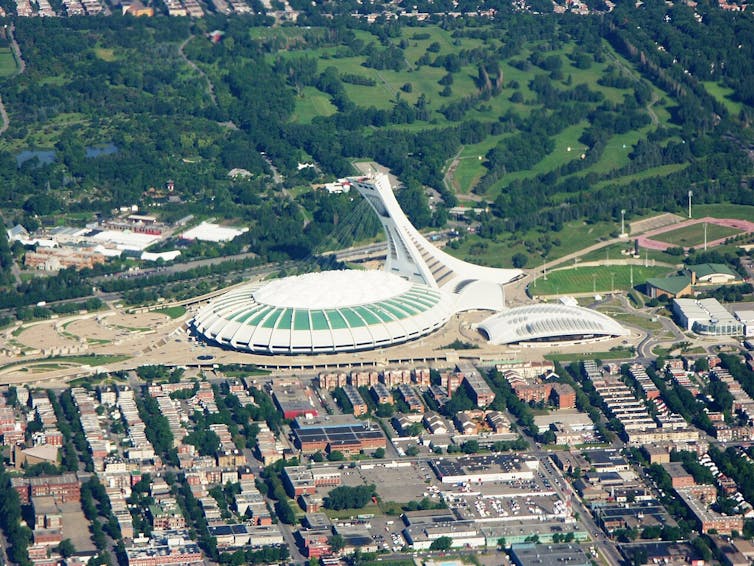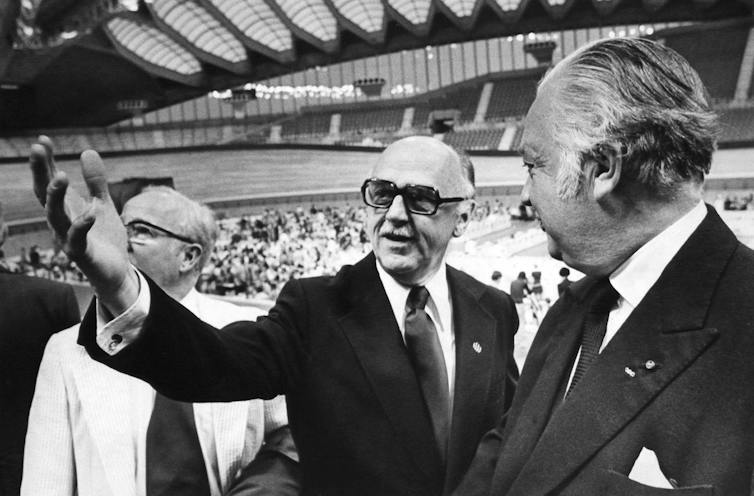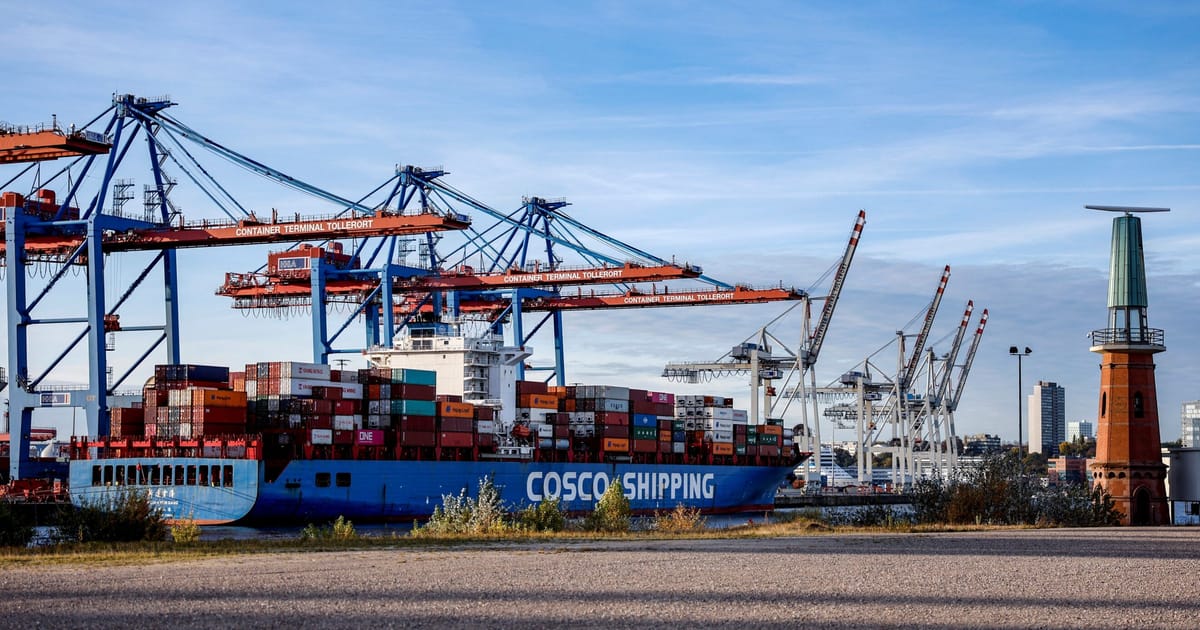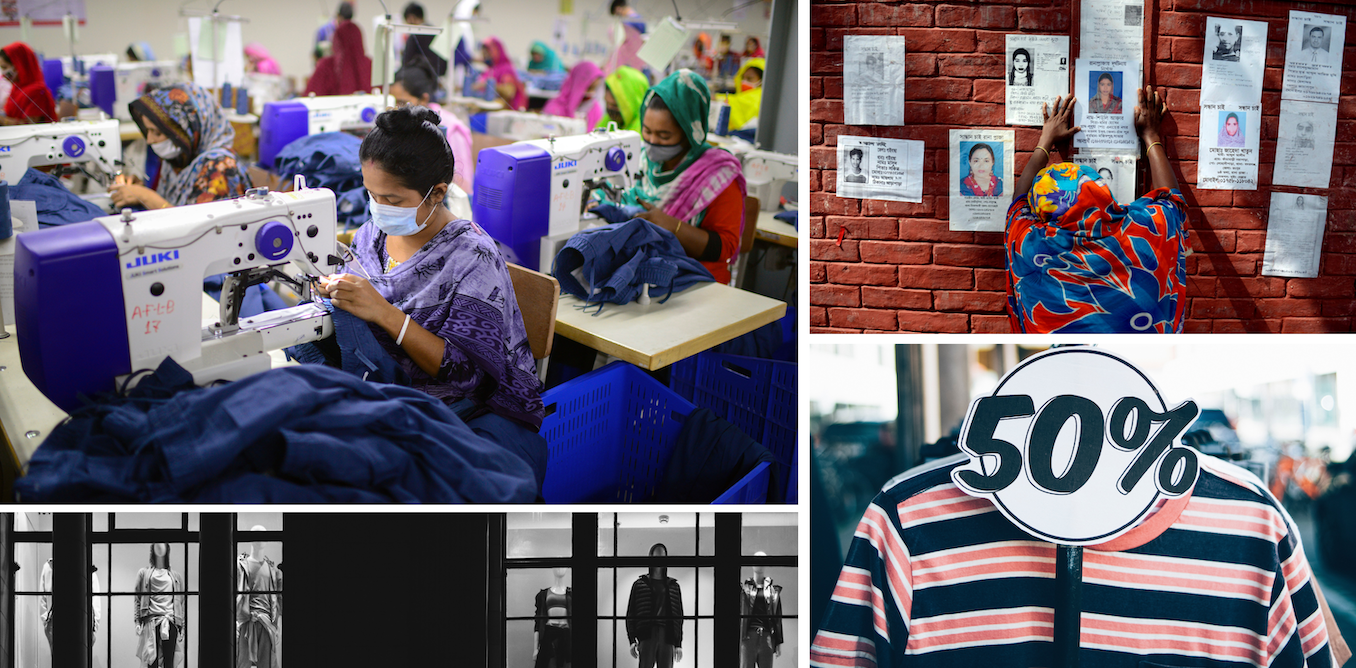With the countdown to the Paris 2024 Olympics in full swing, it’s an ideal time to reflect on legacies of past Olympic Games, including Canada’s past experiences hosting the Games. The legacy of the Montréal Olympic Games is especially relevant this year, as the city is hosting the Olympic trials for swimming and track and field.
The Montréal 1976 Summer Olympics remains the largest sporting event in Canadian history. It is remembered for many things: it was outrageously expensive, costing over $1.5 billion. It took 40 years to pay off the debt, despite Mayor Jean Drapeau’s claim in 1970 that the “Olympics could no more have a deficit than a man could have a baby.”
The Olympic stadium was a disaster: it wasn’t even fully completed for the Games. The event saw gymnast Nadia Comaneci of Romania score a perfect 10, which remains one of the great feats of modern sports. The American team fielded the best boxing team in history. Women’s events were held for the first time in basketball, handball and rowing.
Canada set a record as well: it earned a meagre 11 medals and was the first host country to not win a gold. Taiwan, China and 29 African states boycotted the Games over apartheid South Africa. Twelve men died during the construction of the venues.
Then there were the lesser-known events. The Montréal Fire Department, after hearing from the Royal Canadian Mounted Police that Ukrainian protestors planned to strip down and burn Soviet flags, greased flagpoles around the city with Vaseline (one protestor was injured, and then arrested, in a failed flag-pole climbing incident).
The 1976 Olympics also marked a turning point in Olympic history: it was the first highly visible security operation, which has since become the norm for Olympic Games. After years of requests through the Access to Information Act, the RCMP released more than 50,000 pages of documents on security planning for the Montréal Olympics that provide new insights into the scale and cost of securing the Games.
The road to Montréal
Most remember the Montréal Olympics as a financial disaster. Soaring costs threatened to cancel the Games; Drapeau underestimated the cost so badly the National Assembly hauled him before an inquiry to explain the situation.
The Summer Olympics in Tokyo (1964, $9 million), Mexico City (1968, $12 million) and Munich (1972, $495 million) were dwarfed by the more than $1.5 billion spent in Montréal.
(CP PICTURE ARCHIVE/Doug Ball)
With the exception of Moscow (1980, $1.3 billion), subsequent Games in Los Angeles (1984, $408 million) and Seoul (1988, $531 million) were nowhere near as costly. Unlike other host cities, Montréal had little existing sports infrastructure and needed to build most of its venues.
Social services suffered and several projects had to be put on hold. For many years after the Olympics, Montréal was the only major city in North America that was still dumping waste into adjacent waterways.
Heightened fear of terrorism
Olympics security had not been a serious preoccupation before Montréal. By the 1970s, though, the Games were taking place amidst a heightened fear of international and domestic terrorism.
According to the Global Terrorism Database, there were at least 4,340 terrorist attacks between 1970 and 1976. In the previous five years, two dozen diplomats around the world had been kidnapped, and six others assassinated.
In 1971 and 1972, there were at least 12 aircraft hijackings involving Canadian airlines (metal detectors were introduced in large numbers at airports in 1973). The Front de libération du Québec was responsible for numerous bombings, robberies and killings across Québec throughout the 1960s and the 1970 October Crisis.
In the United States, there were more incidents of domestic terrorism in the 1970s than any other period in history: at least 680 incidents compared to 282 in the 1980s (77 fatalities in the 1970s, 22 in the 1980s).
The Montréal Olympics also took place in the shadow of the Munich massacre — a terrorist attack carried out by the Palestinian militant group, Black September, against members of the Israeli Olympic team during the 1972 Summer Olympics. Eleven Israelis (including nine hostages), five of the terrorists and one policeman were killed in the incident.
Over five million people would attend the Summer Olympics in Montréal, more than Tokyo in 1964 and Munich in 1972. Such a massive gathering was bound to strain Canada’s limited security apparatus. It was uncommon for such a small country (25 million at the time) to host a Summer Olympics.
The security operation
The overall operation was impressive. A security force of 17,224 included 8,940 Canadian Forces; 1,606 Montréal Urban Community Police; 1,376 RCMP; and 1,140 Sûreté du Québec.
Security personnel also included officers from the Metropolitan Toronto Police, Ontario Provincial Police, National Harbours Board Police, Manpower and Immigration, the Montréal Fire Department and 2,910 private security guards — all to protect fewer than 6,000 athletes.
Rather than spreading the Village across the city (as was the case in past Games), the Montréal Olympic Village was a towering 19-storey pyramidal structure with limited access and a 10-foot high wire fence. Athletes were driven to competition sites on buses with armed soldiers or police officers, while soldiers with automatic weapons patrolled the Village.

(Bob Jagendorf)
Security was provided for 13 competition sites and 27 training sites, as well as the Village. The Sûreté du Québec alone drew officers from 47 detachments across the province scattered over six districts, and drove 1,462,159 miles in 26 vehicles (and 112 hours in helicopters) over the 46-day operation.
Military personnel who were assigned to assist the police were deputized as law enforcement officers, which authorized soldiers to arrest anyone breaking a law in the absence of police.
The federal government passed special immigration legislation allowing the minister of immigration to deport anyone who might engage in violence during the Olympics. It was an unusual statute: only one sentence, which gave the minister unfettered power to deport non-citizens with no right to appeal.
Meanwhile, local law enforcement was dramatically enhanced, including a squad of 24 officers to police pickpockets. The crime rate in Montréal dropped by more than 20 per cent during the Games.
The cost of security
An initial federal budget of $14.3 million dollars for the RCMP was later augmented to $23 million. In addition, the Department of National Defence estimated it cost the ministry $21 million to provide security for the Olympics.
The Montréal Olympic Committee paid $1.8 million for private security. The Montréal Urban Community Police also had a budget of $1.8 million for the Olympics (including regular salaries that would have been paid anyway). The Ontario Provincial Police paid an extra $1.9 million to have 350 officers provide security for the royal visit and sailing competitions in Kingston.
While there were some unknown costs, such as those for overtime pay and additional security, the total cost for security at the Montréal Olympics was likely about $52 million (or $262 million in 2023 dollars). While this was small compared to the overall costs, it was dramatically higher than Munich’s paltry $2 million budget four years earlier.
The Montréal Olympics may be remembered for many things, but its most significant impact was inaugurating a new era of security planning for the Olympics. When Vancouver hosted the Games 34 years later, the estimated cost of security was over $1 billion.
The security budget for the upcoming 2024 Paris Olympics this summer is 320 million euros ($468.37 million) out of an overall budget of 8 billion euros ($11.7 billion). This is perhaps the most enduring legacy of the Montréal Olympics.




